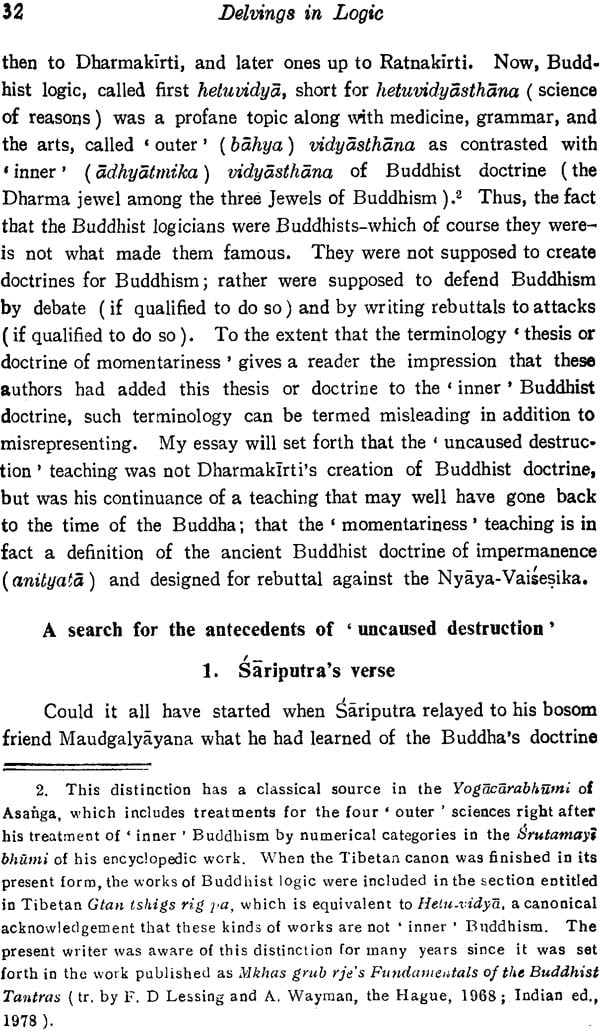
Delvings in Logic by Alex Wayman (A Rare Book)
Book Specification
| Item Code: | NAD290 |
| Author: | Alex Wayman |
| Publisher: | Bhandarkar Oriental Research Institute, Pune |
| Language: | English |
| Edition: | 1987 |
| ISBN: | 9788194102649 |
| Pages: | 52 |
| Cover: | Paperback |
| Other Details | 8.5 inch x 5.5 inch |
| Weight | 70 gm |
Book Description
On July 2—3, 1956, Professor Alex Way man delivered two lectures at the Bhandarkar Oriental Research Institute under the “Acbarya Dharmananda Kosambi Memorial Lectureship” (Second Series). Professor Way man is by no means a stranger to this Institute. He is a Life Member of this Institute and has been actively collaborating in its academic activities whenever called upon to do so.
It may cause surprise to many to know that Professor Way man received his initial University training in Mathematics. It was only after obtaining his master’s degree in Mathematics at the University of California, Los Angeles that he turned to Sanskrit and Tibetan languages for his doctoral work. It is not unlikely that it is Professor Wayman’s training in Mathematics which has invested his Oriental studies with a certain discipline and preciseness. Wayman began his career as a University teacher in 1960 with a Visiting Lecturership in Buddhism and Indic Studies at the University of Michigan in Ann Arbor. Later he served at the University of Wisconsin, Madison, for seven years, and, in 1967, was appointed to the Professorship of Sanskrit at the Columbia University, N. Y., which post be continues to hold at present.
But Wayman had been active in the field of research even since before he had obtained his doctorate in 1959. For instance, I still recall some of his earlier writings such as “The Sanskrit term janana” (where he suggests that jinana, vidya, and vij7ina can be satisfactorily translated by their respective cognates — knowledge, wisdom, and perception) and “The meaning of unwisdom (avidya) “. His contributions arising out of a comparative study of Brahmanism Hinduism and Buddhism such as those dealing with Yama and Mära, the Hindu-Buddhist rite of truth (where he emphasises the creative nature of truth in Vedic literature), and the two traditions of India (where he sets forth a rivalry between the Upanishad tradition of “truth” and the Buddhist tradition of “silence “), are particularlystimulating. Professor Wayman has also written on such diverse topics as “Climactic times in Indian mythology and religion “, “Significance of dreams in India and Tibet “, “Four periods in the history of Indian astrology “, “ Significance of mantras “, “ The goddess Sarasvati — from India to Tibet “, and “ Buddhist dependent origination (prafltyasamutpada) “. From among his major works I may mention A nalysis of the thavakubhimi Manuscript, Yoga of the Guhyasamjatantra, calming the Mind and Discerning the Real (translated from the Lam rim chen mo of Tsoñ-kha-pa), and Buddhist insight (Collection of Essays). Seven volumes, by different scholars, have so far been published in the Buddhist Traditions Series edited by Professor Wayman.
Let me, however, hasten to add that it was not my intention to present any kind of exhaustive bibliography of Professor Wayman’s writings. All that I have endeavored to do is to indicate broadly the wide range of his scholarly interests.
Professor Wayman has fruitfully participated in various international conferences, seminars, and symposia and has thereby established useful academic contacts with scholars in many countries.
The Bandera Oriental Research Institute rejoices in having had such a gifted senior Ideologist to deliver these two lectures under the lectureship which commemorates India’s pioneering B ideologist, Acharya Dharmananda Kosambi.
| Lecture One | ||
| The Term Guna — a problem in Communication | 1—30 | |
| Introductory remarks | 1 | |
| 1 | A word and its meaning | 1 |
| 2 | The term gu1a in the creation | |
| theory of the Anugitã | 5 | |
| 3 | Some lists of guIas | 8 |
| a. | A list from Jam sources | 9 |
| b. | A Nyäya and Vaieika list | 10 |
| c. | From Kautiiya’s Arthaästra | 13 |
| d. | Daidin’s ten | 13 |
| e. | Utpal’s citation | 15 |
| f. | From the NItLãstra | 16 |
| 4 | The contrast of guna and doa | 16 |
| 5 | A trial example of communication | 20 |
| 6 | The Guna of grammar | 23 |
| 7 | Are gunas both perceptible and inferable | 26 |
| Concluding remarks | 30 | |
| Lecture Two | ||
| The Controversy Over Dharmakirti’s Uncaused | ||
| Destruction | 31—48 | |
| Introductory remark | 31 | |
| A search for the antecedents of ‘ Uncaused destruction’ | ||
| 1 | Sariputra’s Verse | 32 |
| 2 | Nägãrjuna’s Verse | 35 |
| 3 | Asañga’s Verse | 38 |
| 4 | Dharmakirti’s Verse | 39 |
| The momentariness teaching | 43 |







